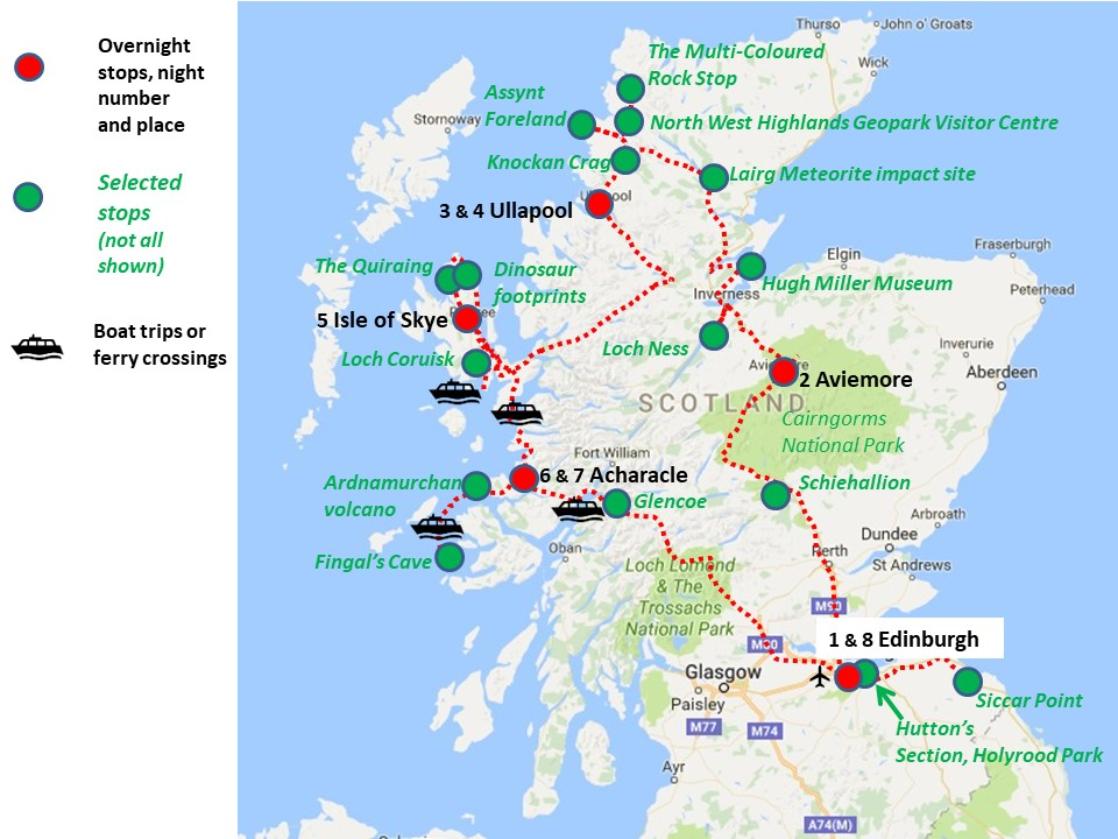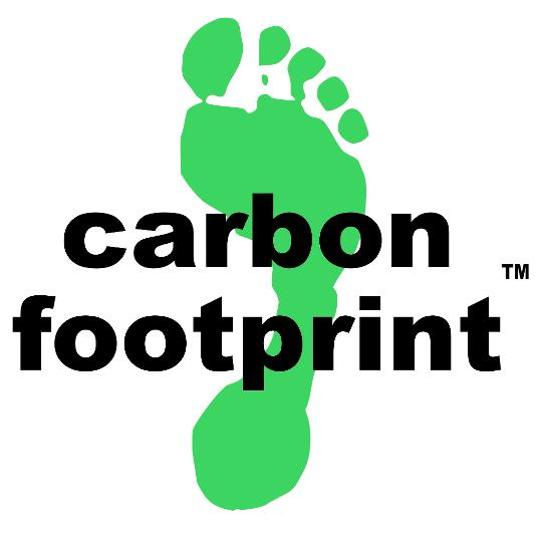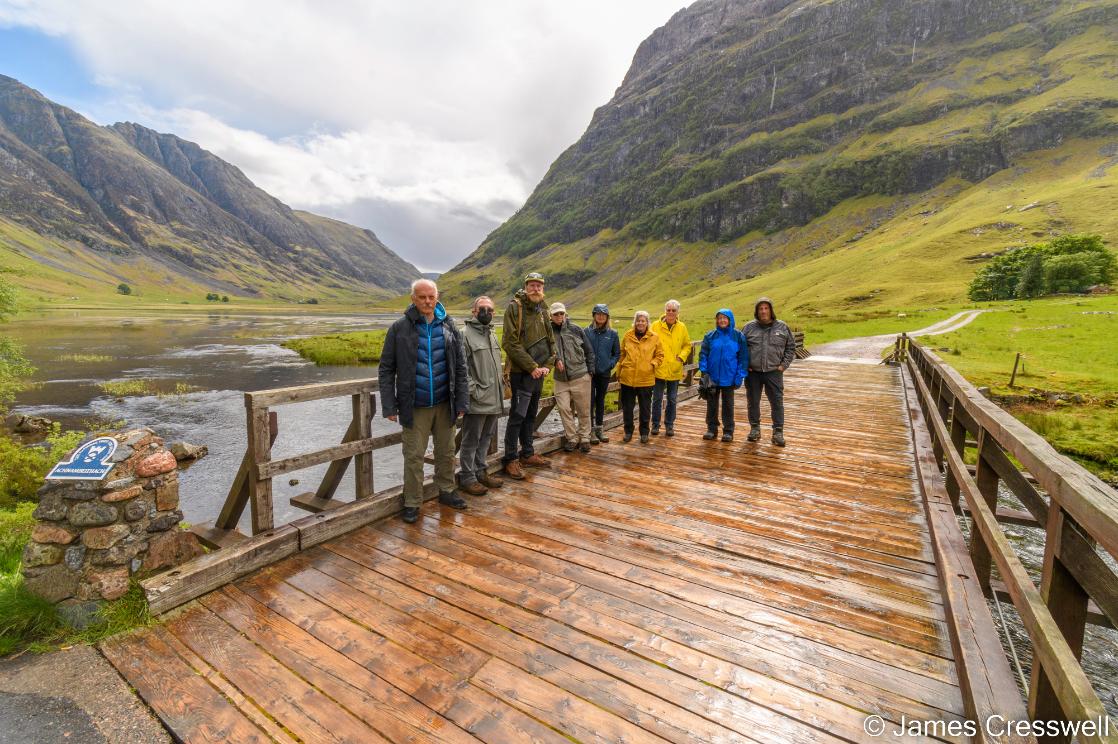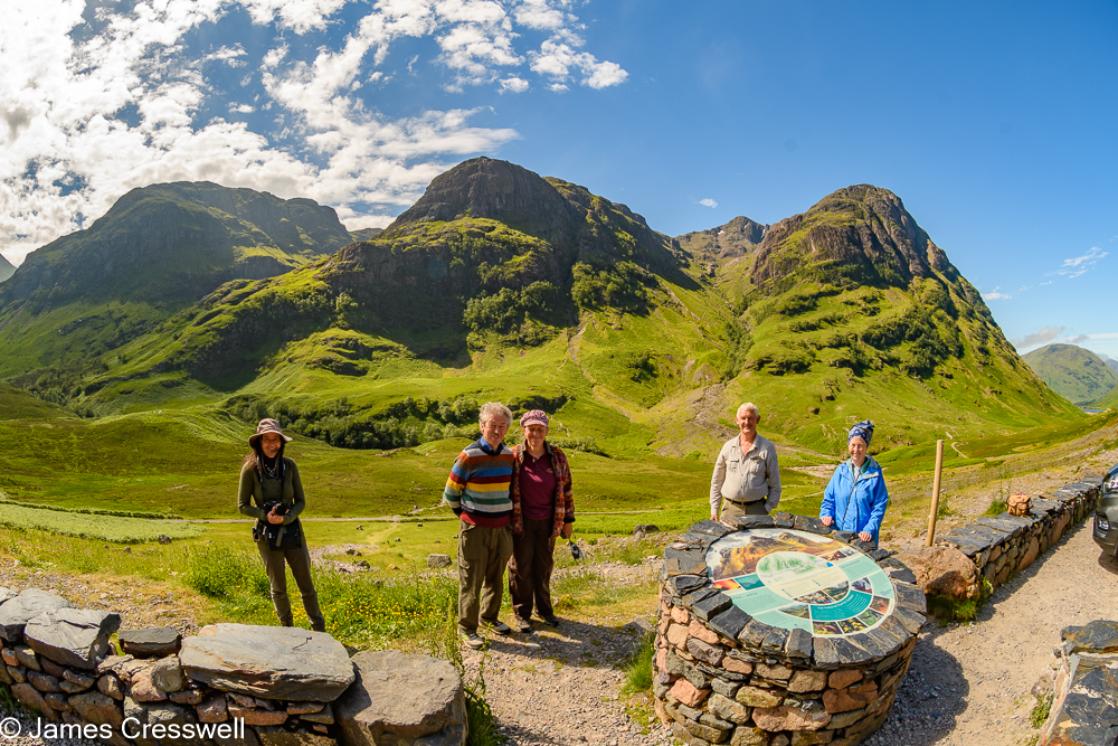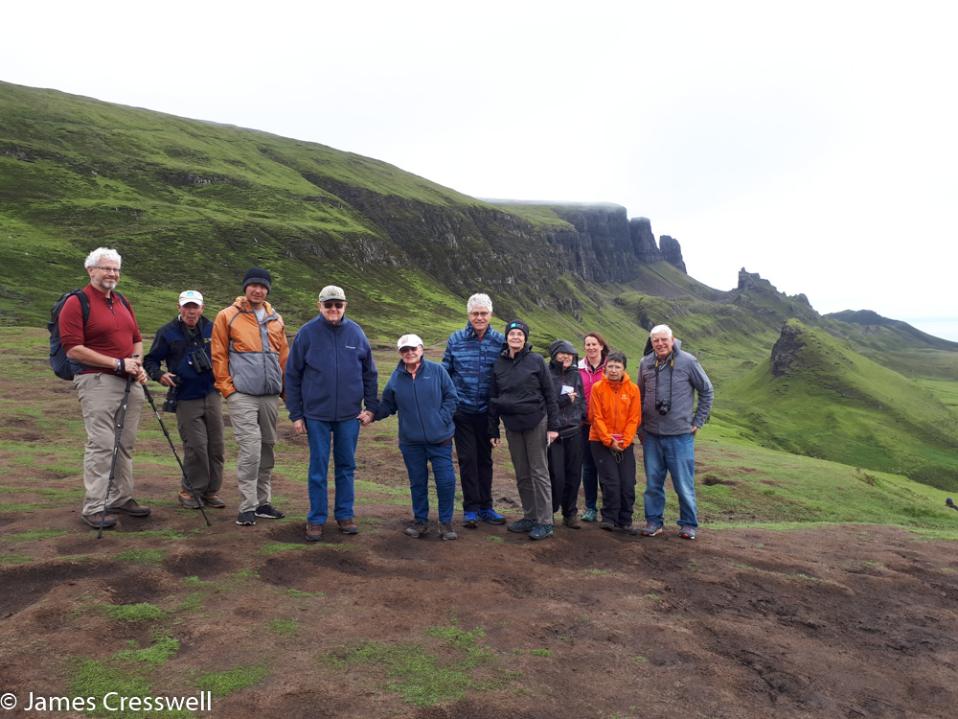ScotlanD
The Birth of Geology
Edinburgh to EdinburgH
Exclusive small group tour. Number of participants : 12-16
8 - 16 June 2026 *FULL* (waitlist available)
9 days/8 nights
£2,350
* * * * *
14-22 September 2026 *FULL* (waitlist available)
9 days/8 nights
£2,425
Prices are per person, based on 2 people sharing a room, bed & breakfast accommodation. Single supplement applies, please make contact for details.
Includes 2 World Heritage Sites, 1 UNESCO Global Geoparks, 1 National Geopark and 2 National Parks
and some of the world's most important geosites for the history of geology
This trip is aptly named the ‘Birth of Geology’ for it is in Scotland that many of the world’s most important historic geosites occur, such as Siccar Point where the enormity of geological time was first realised and Knockan Crag where the world’s first identified thrust fault can be seen. The trip is also a journey through geological time with rocks ranging in age from some of the oldest in Europe, e.g. the 3 billion year old Lewisian gneiss, to lavas that formed in the splitting of the Atlantic just 50 million years ago e.g. Fingals Cave. With 6 former volcanoes, some of the world’s best preserved mid Jurassic dinosaur footprints, and breath taking glacially eroded scenery, this tour takes in a large swath of Scotland.
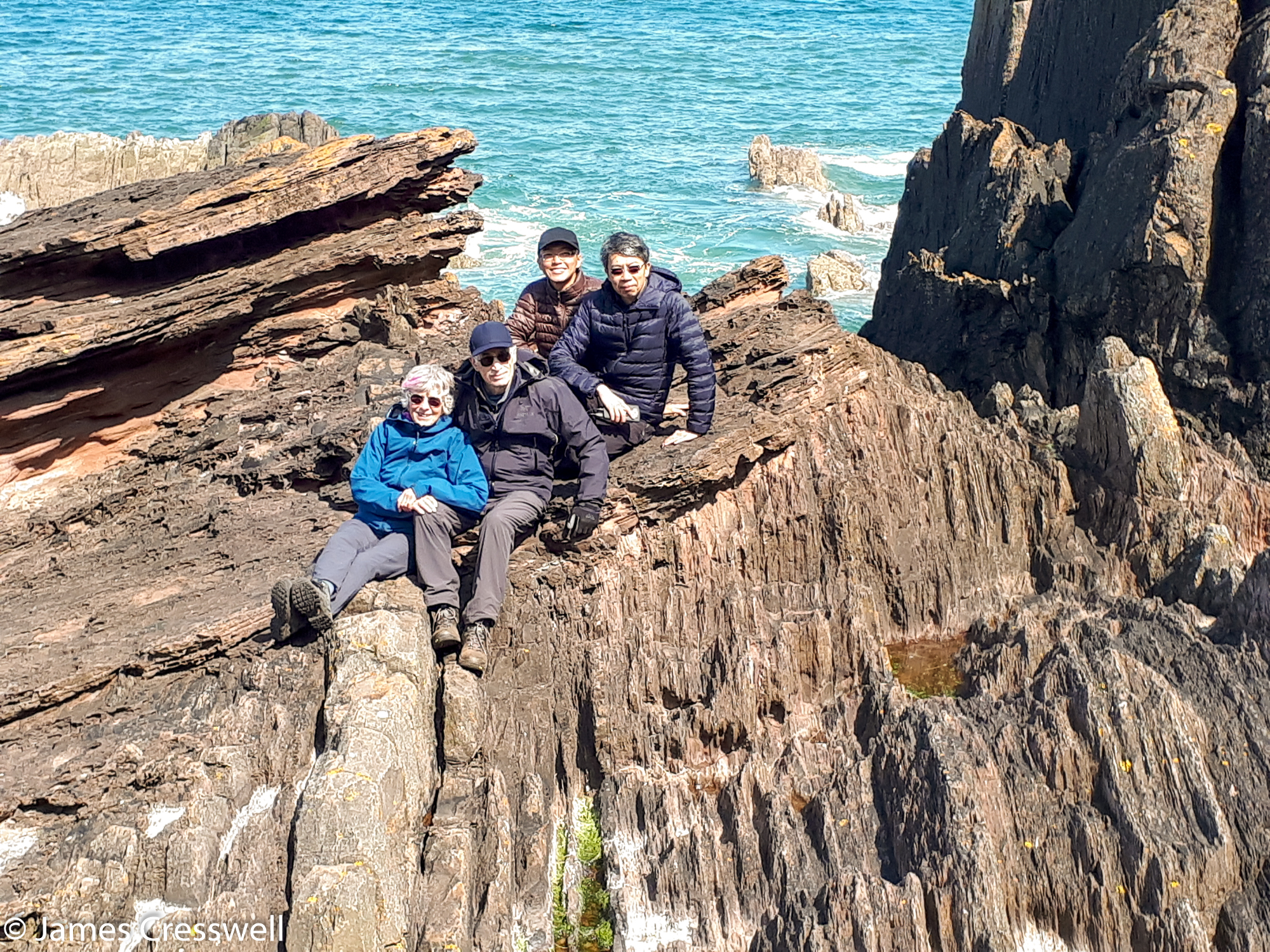
Siccar Point, arguably the world's most important geosite, where the enormity of geological time was first conceived (Day 2)
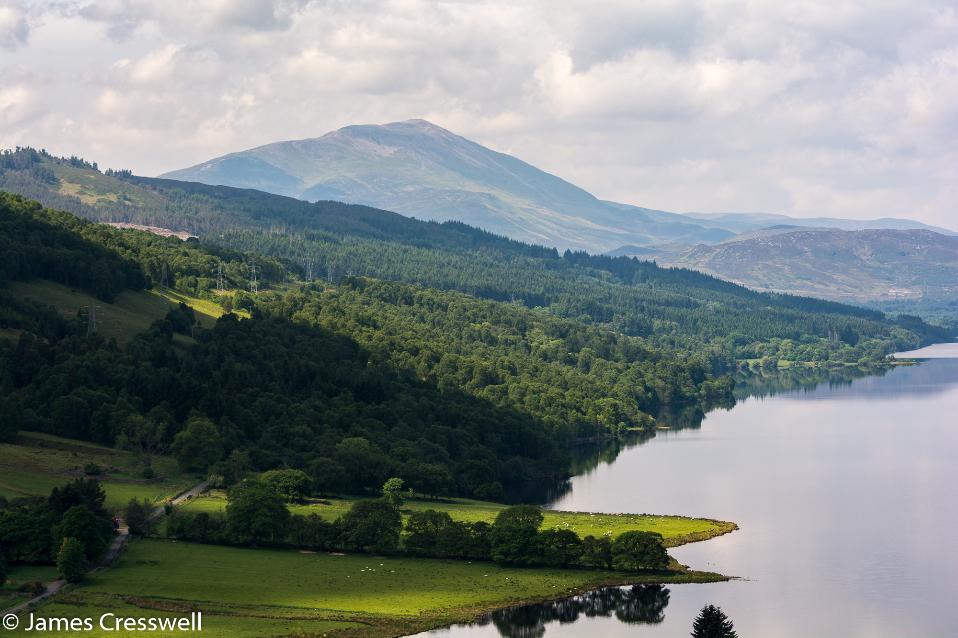
Schiehallion Mountain, where the first attempts to measure the mass of the Earth were made, seen from the Queens View (Day 2)
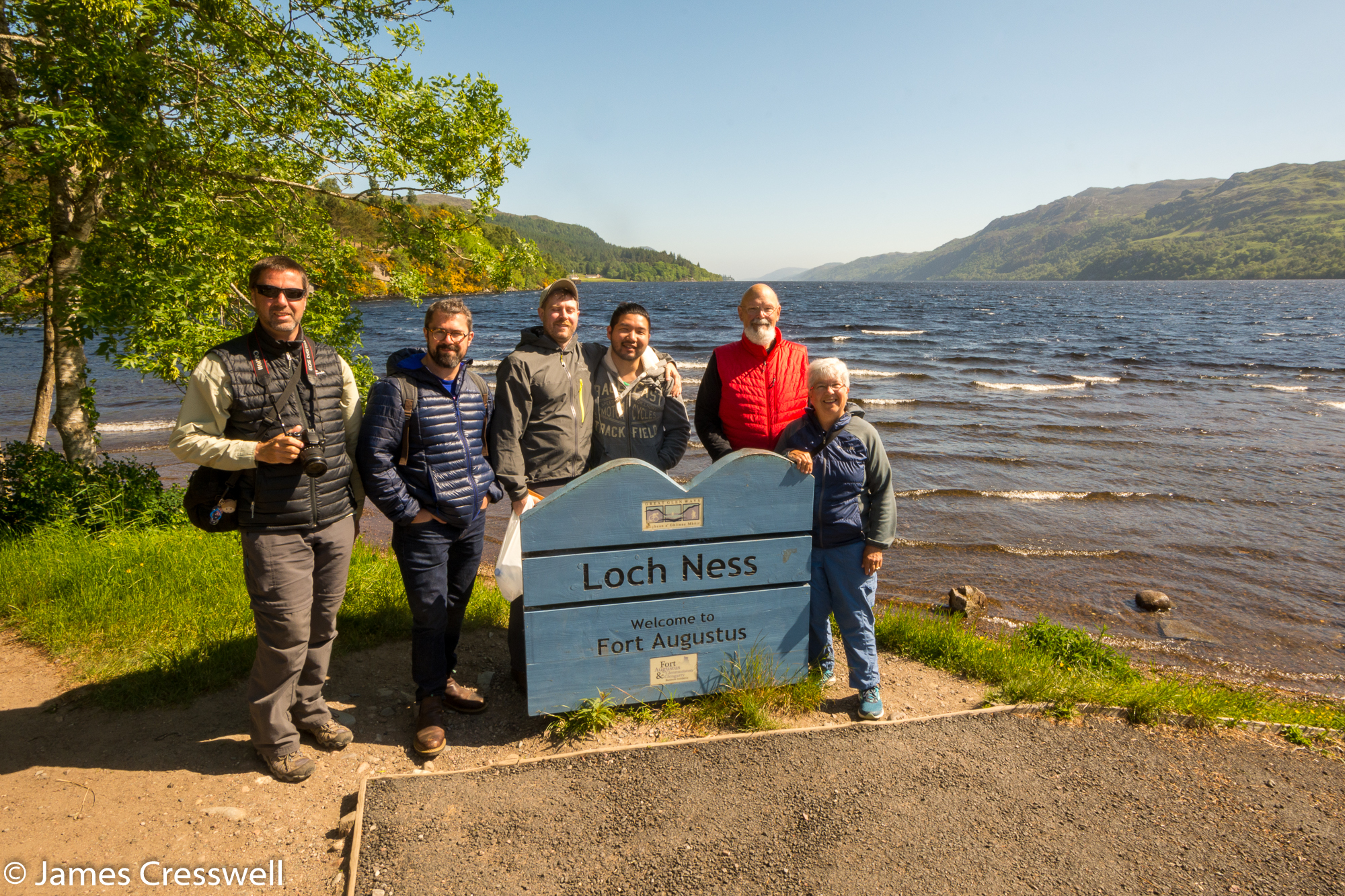
Loch Ness on the Great Glen Fault, is the largest volume of freshwater in Britain and was created by glacial erosion (Day 3)
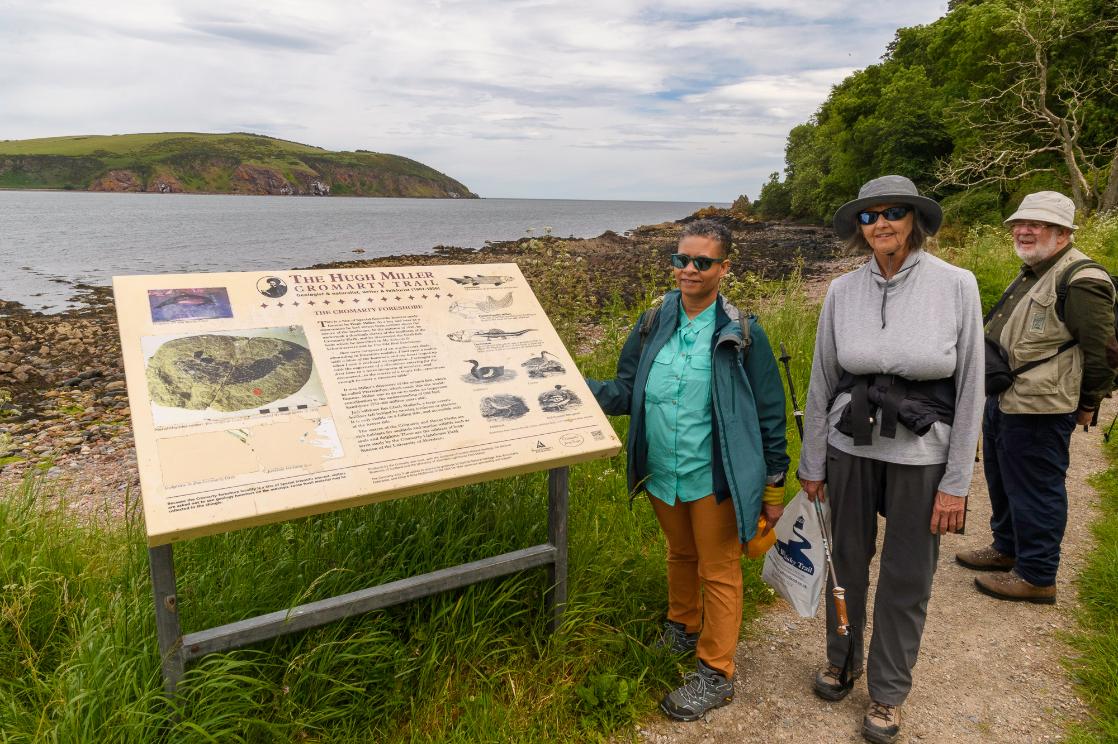
The Cromarty foreshore, one of the sites where Hugh Miller found his famous Devonian fossil fish (Day 3)
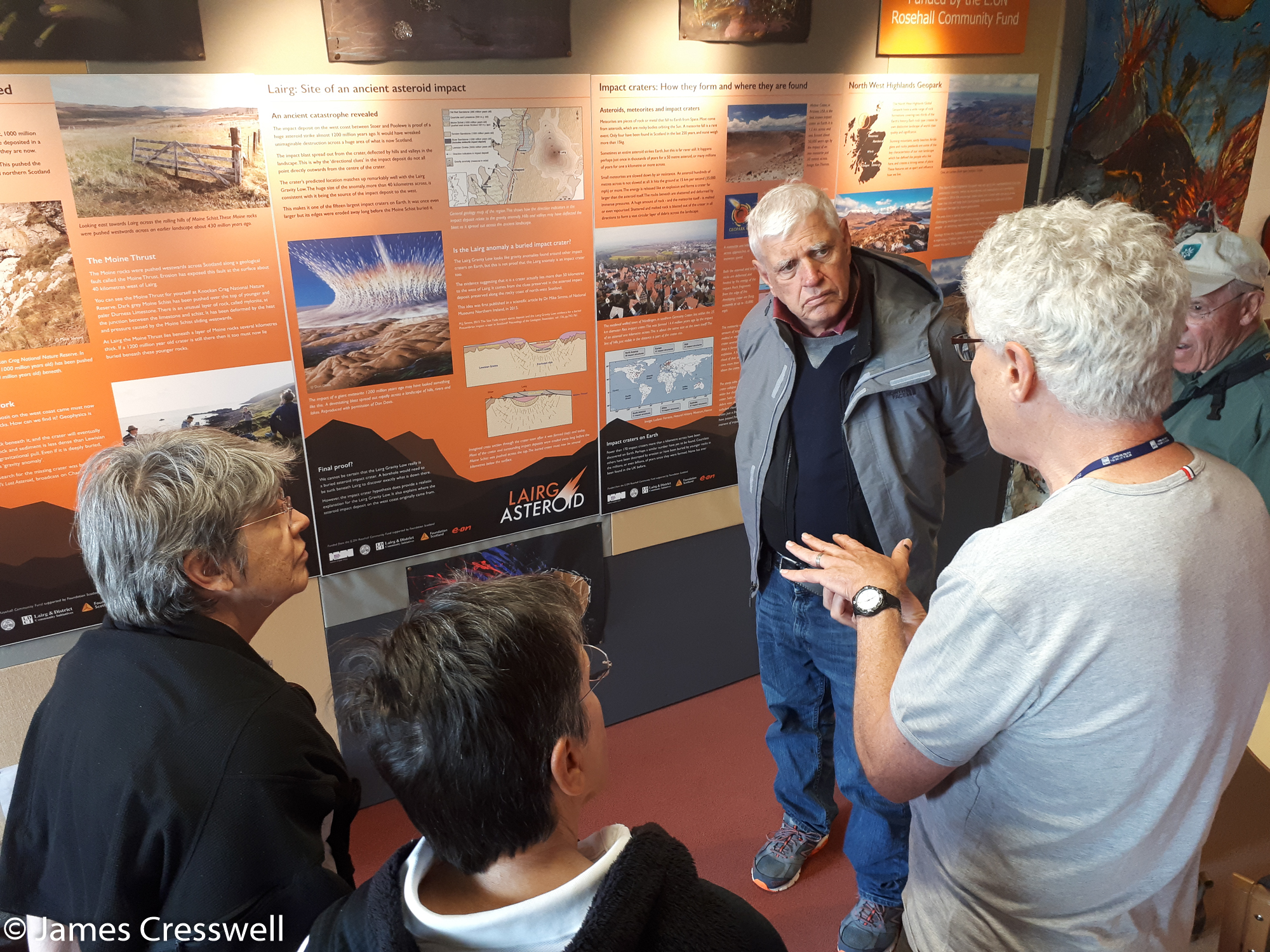
Learning about the Lairg Asteroid at the Ferrycroft Visitor Centre (Day 3)
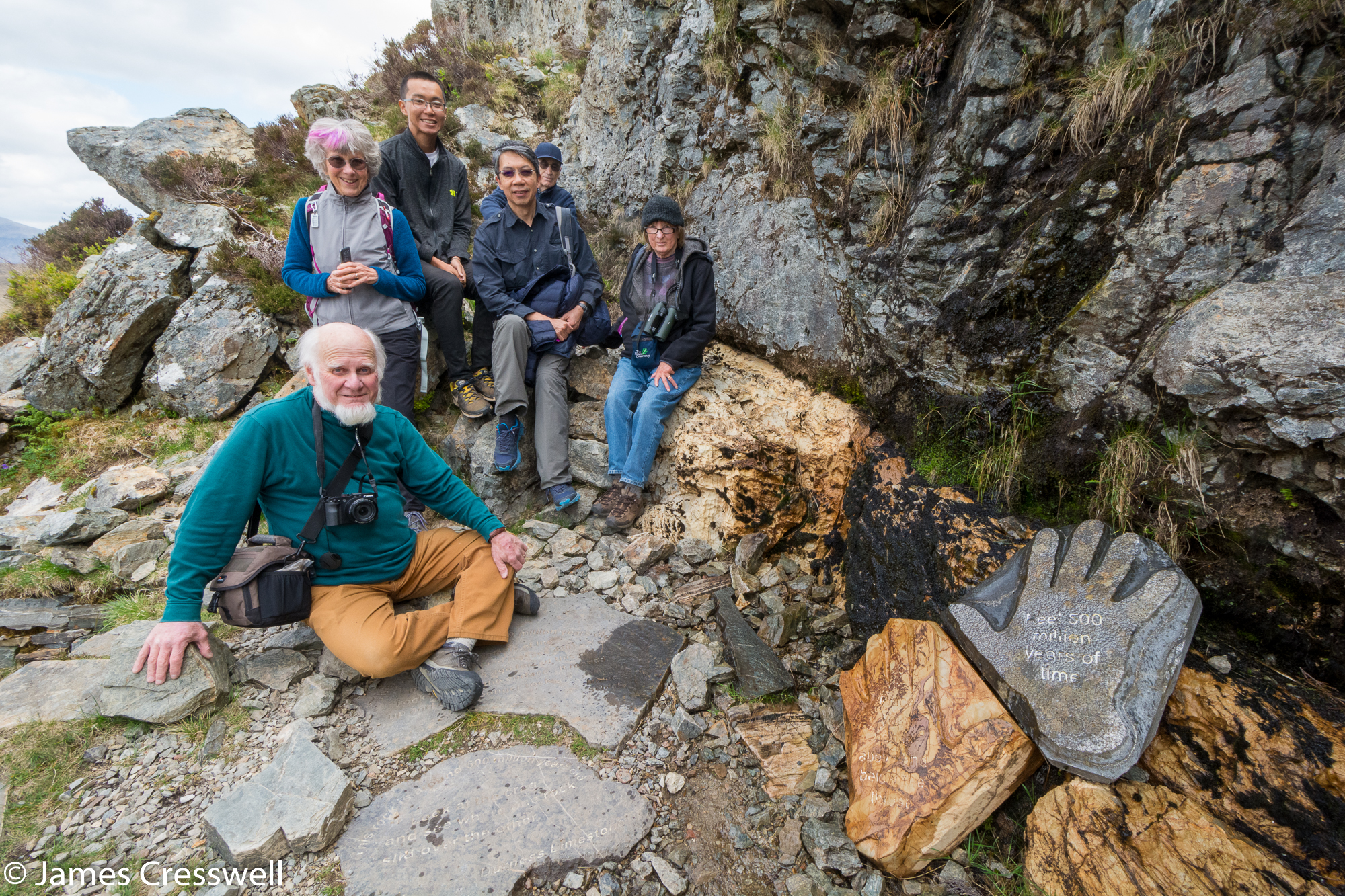
The Moine Thrust at Knockan Crag (Day 3)
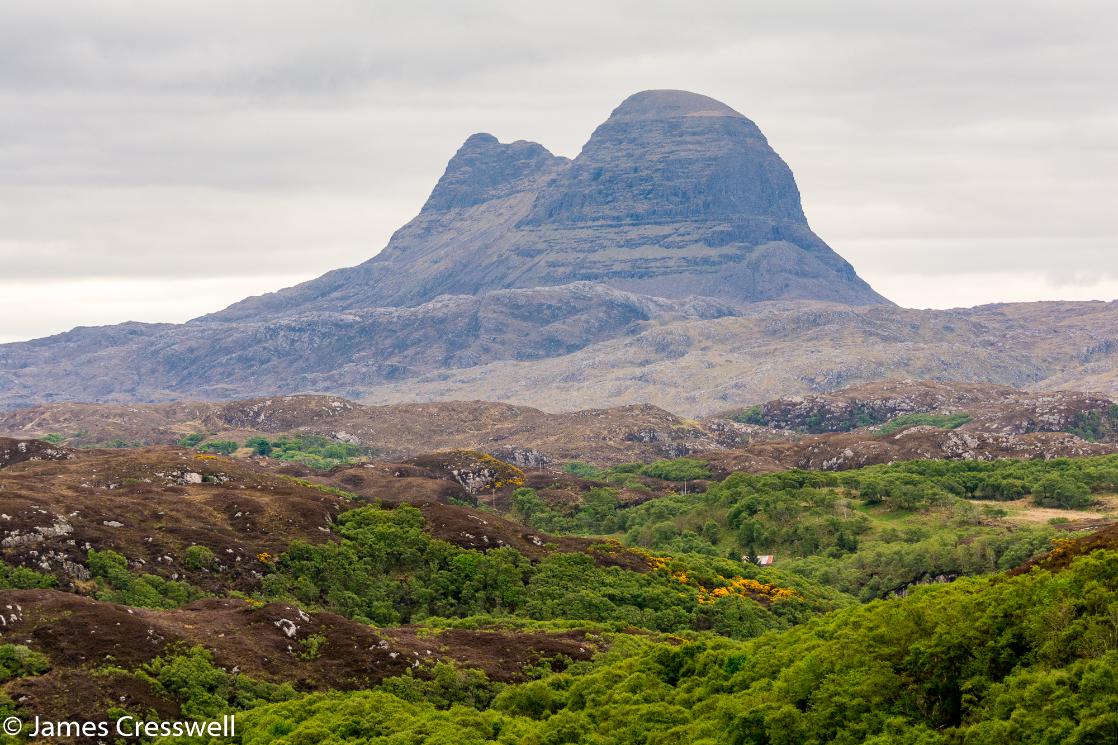
Suilven part of the Assynt Foreland Mountains which was voted the number one geosite in the UK and Ireland, by the Geological Society in 2014 (Day 4)
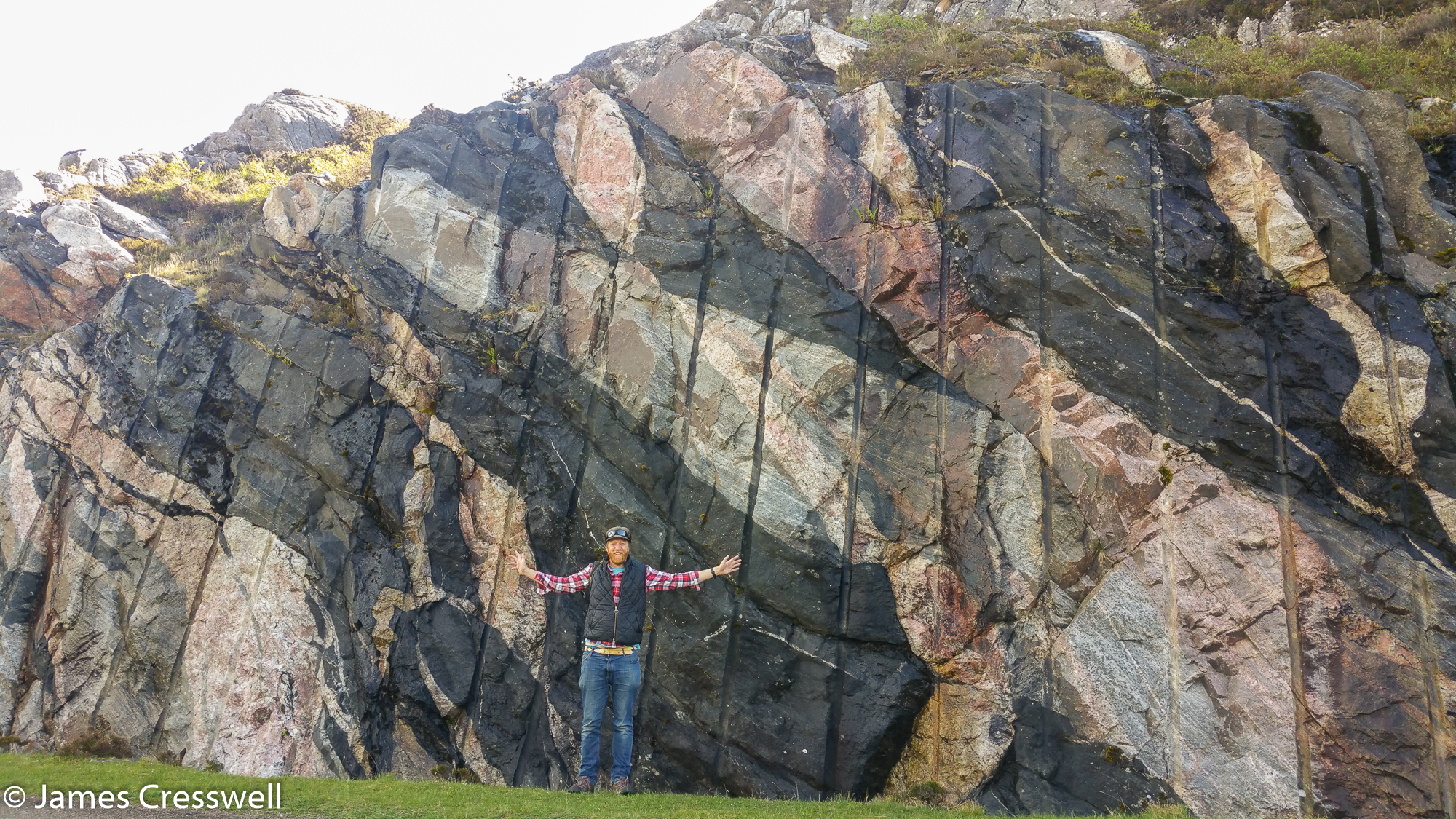
James at the 'Multi-Coloured Rock Stop' in three-billion-year-old Lewisian Gneiss near Laxford Bridge (Day 4)
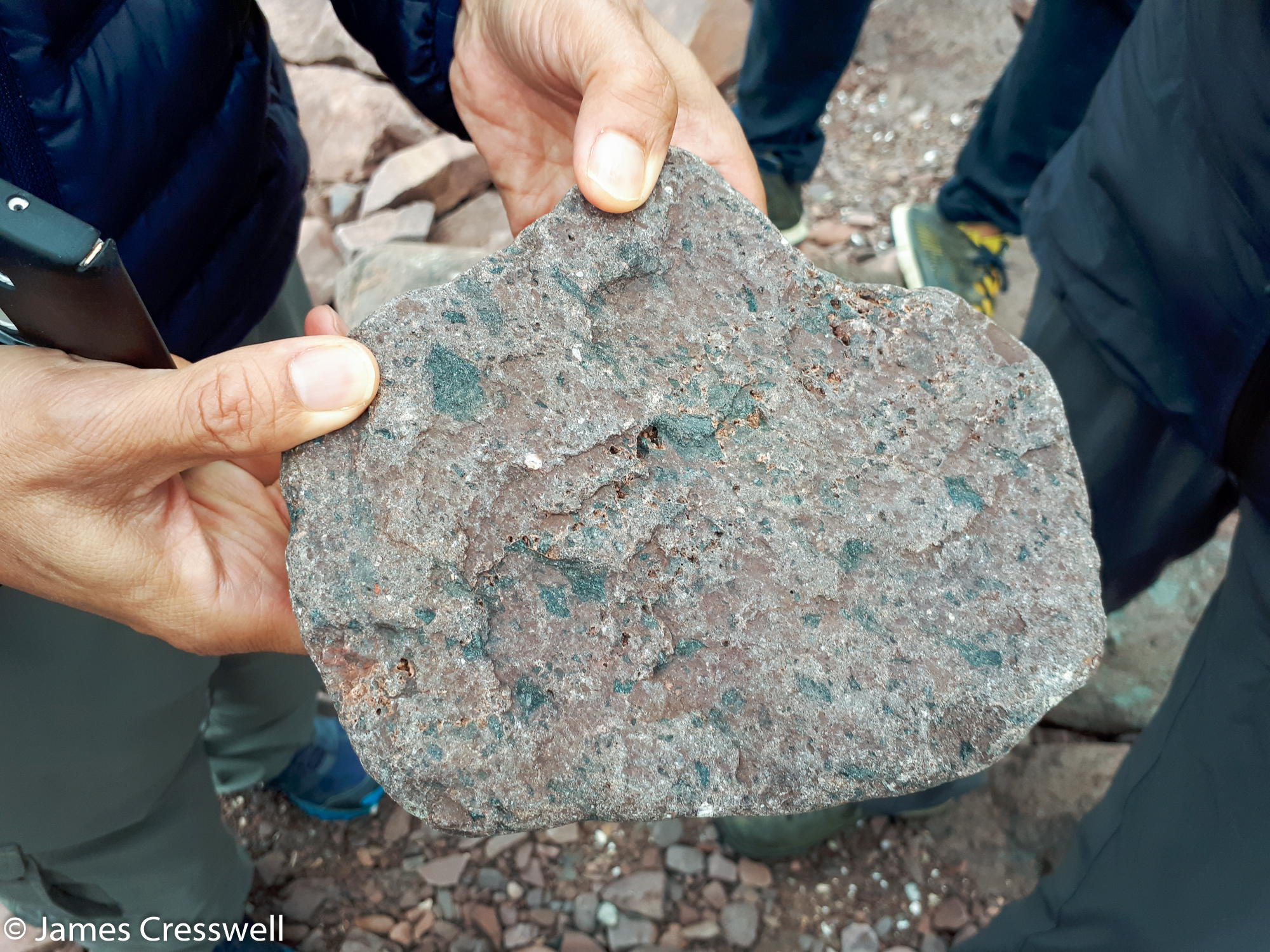
One-billion-year-old tektite at Stoer, probably produced by the Lairg Asteroid impact (Day 4)
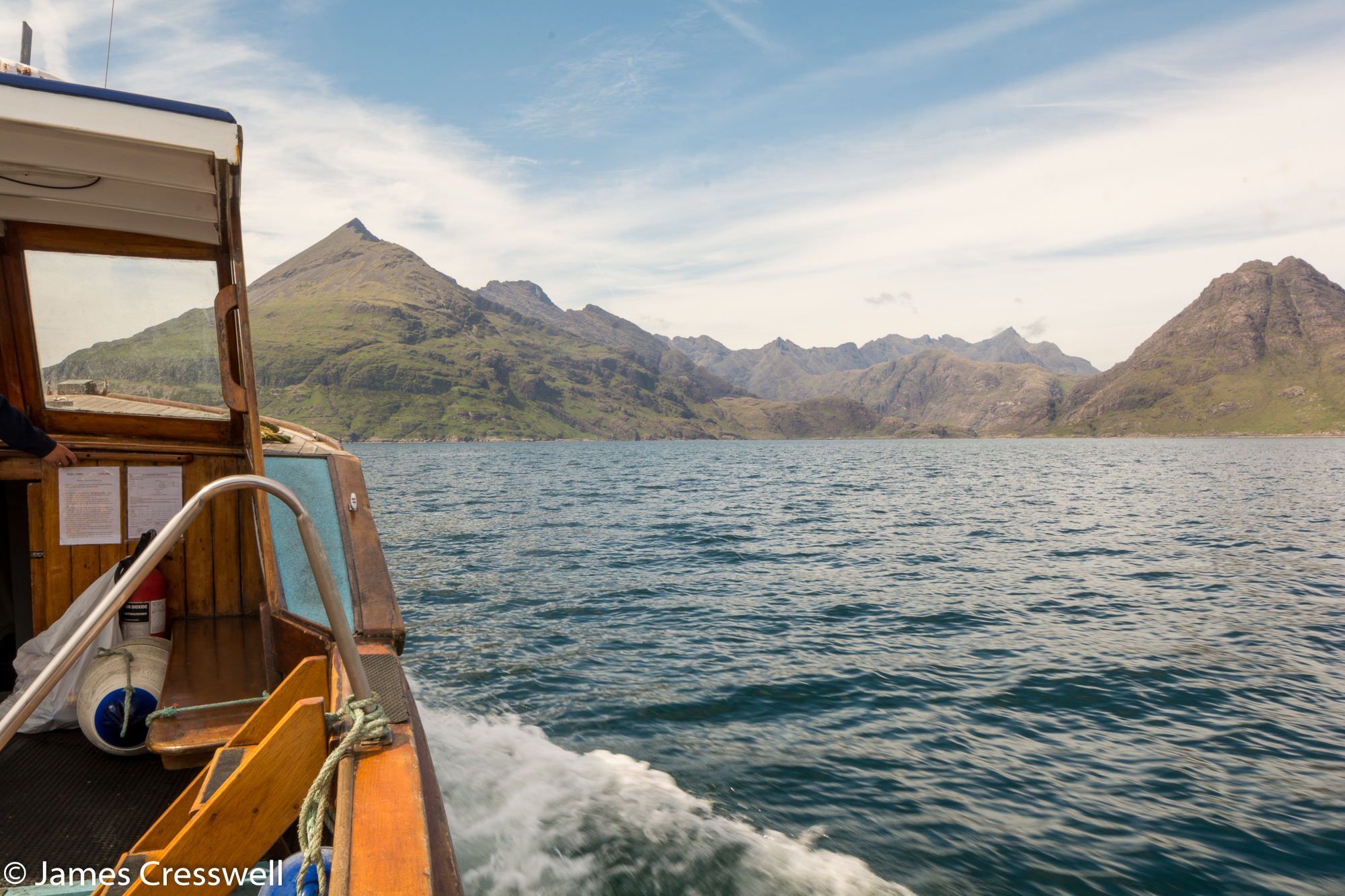
The boat tour to Loch Coruisk in the Black Cuillin on the Isle of Skye (Day 5)
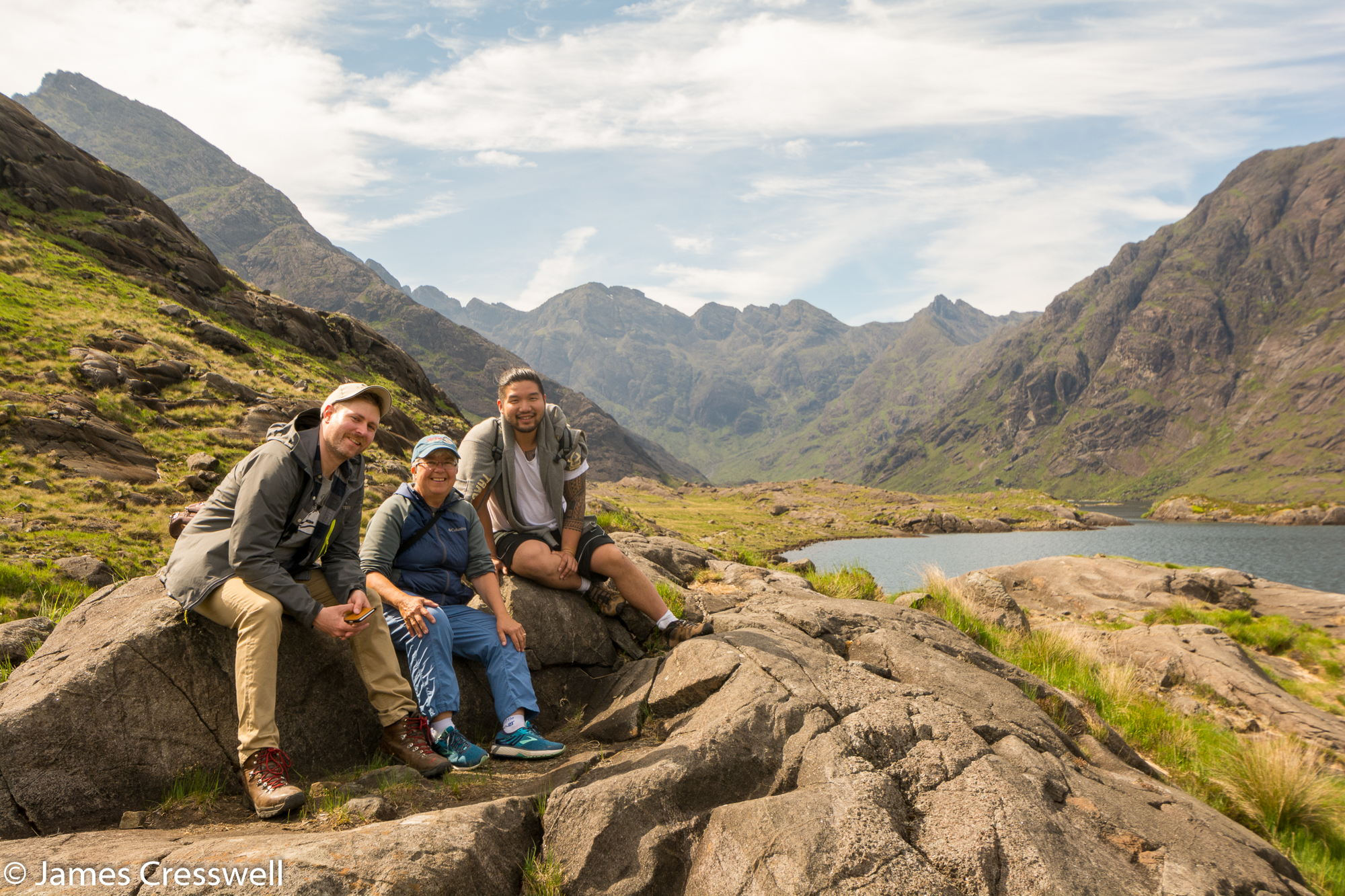
Loch Coruisk and the Black Cuillin on the Isle of Skye (Day 5)
Honeycomb weathering in Jurassic limestone, Elgol (Day 5)
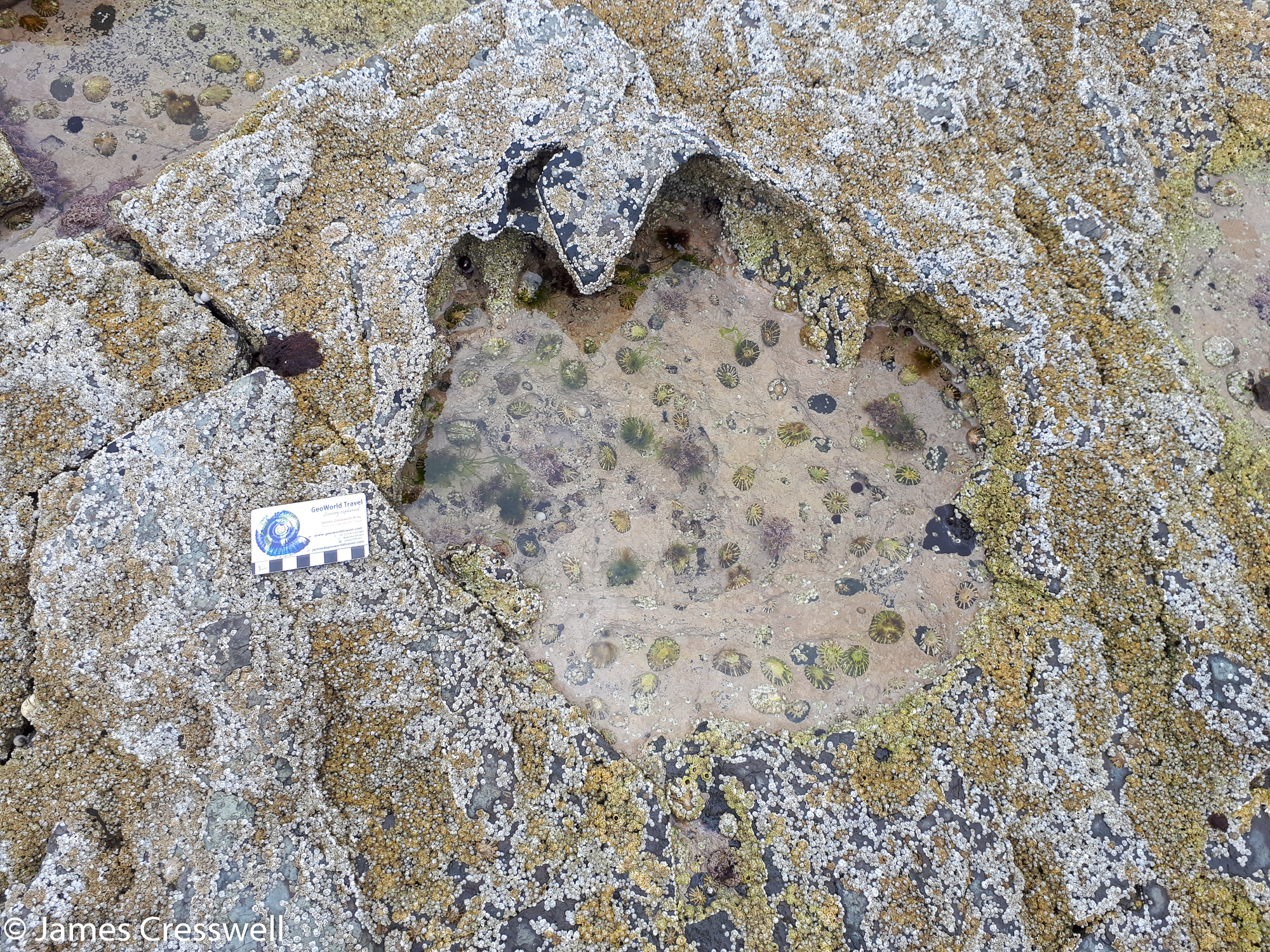
A mid Jurassic sauropod dinosaur footprint on the Isle of Skye (Day 6)
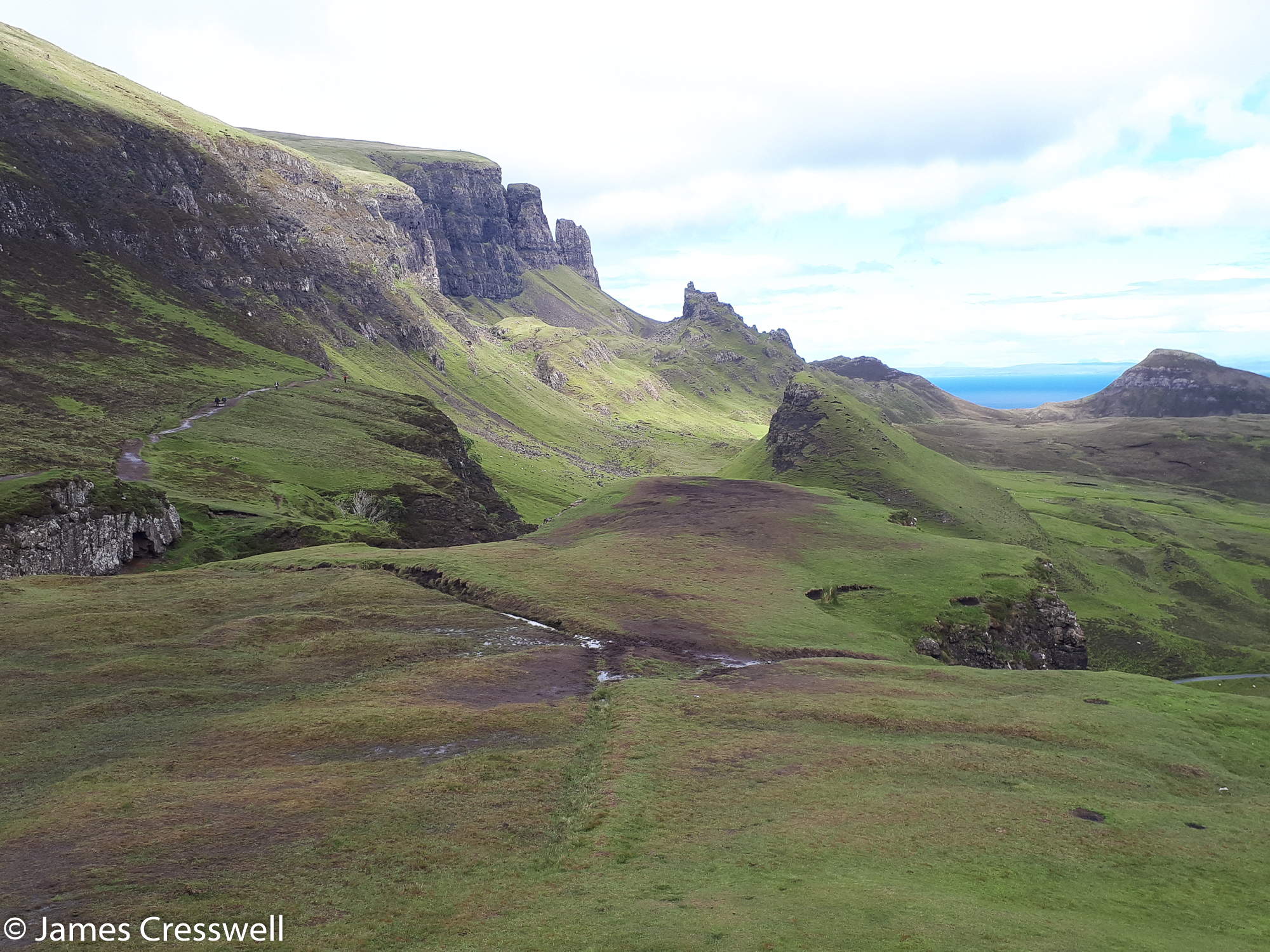
The Quiraing and Trotternish landslip, Isle of Skye (Day 6)
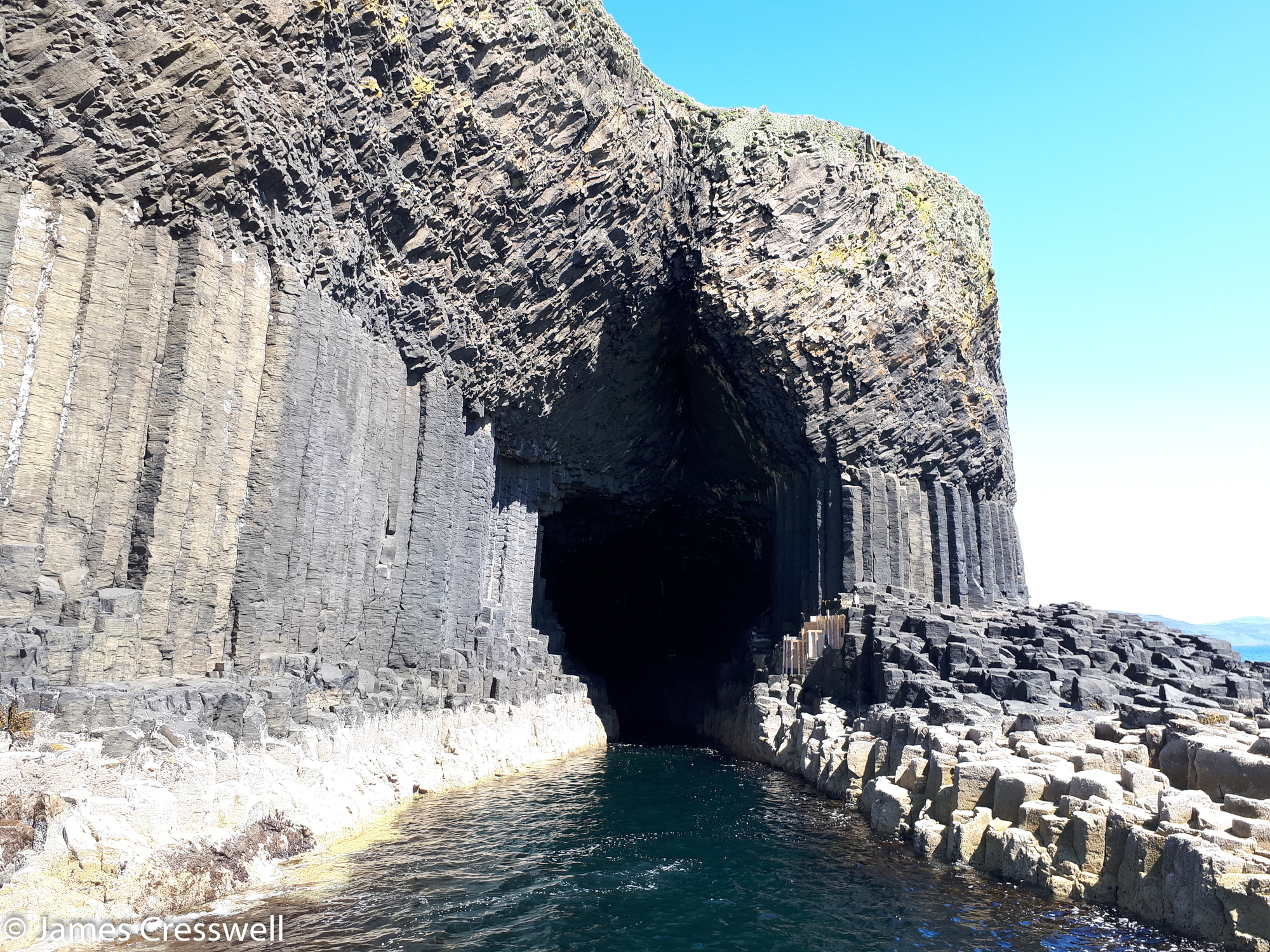
Fingal's Cave on Staffa (Day 7)
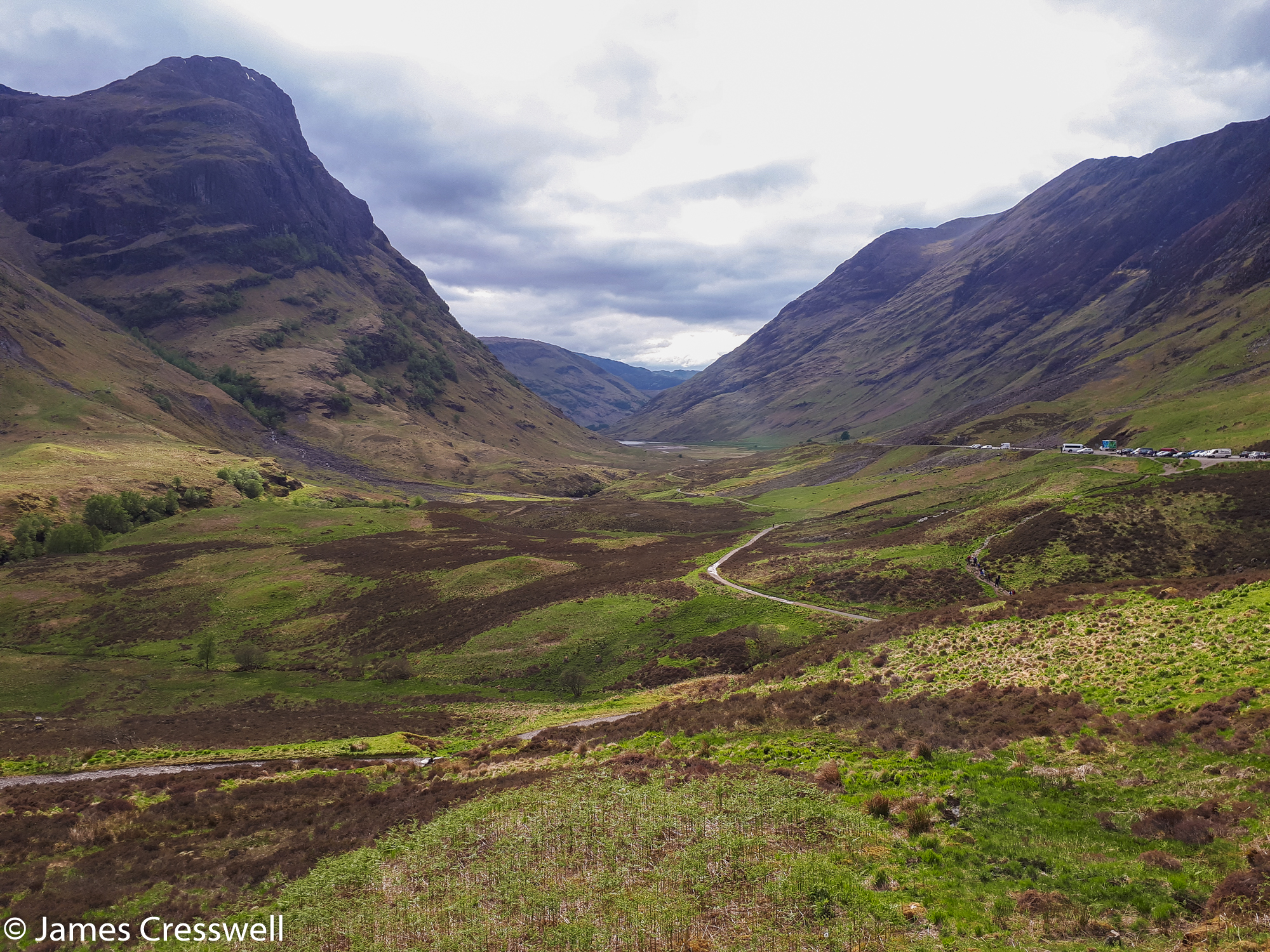
The glaciated valley ofGlencoe in the Lochaber Geopark (Day 8)
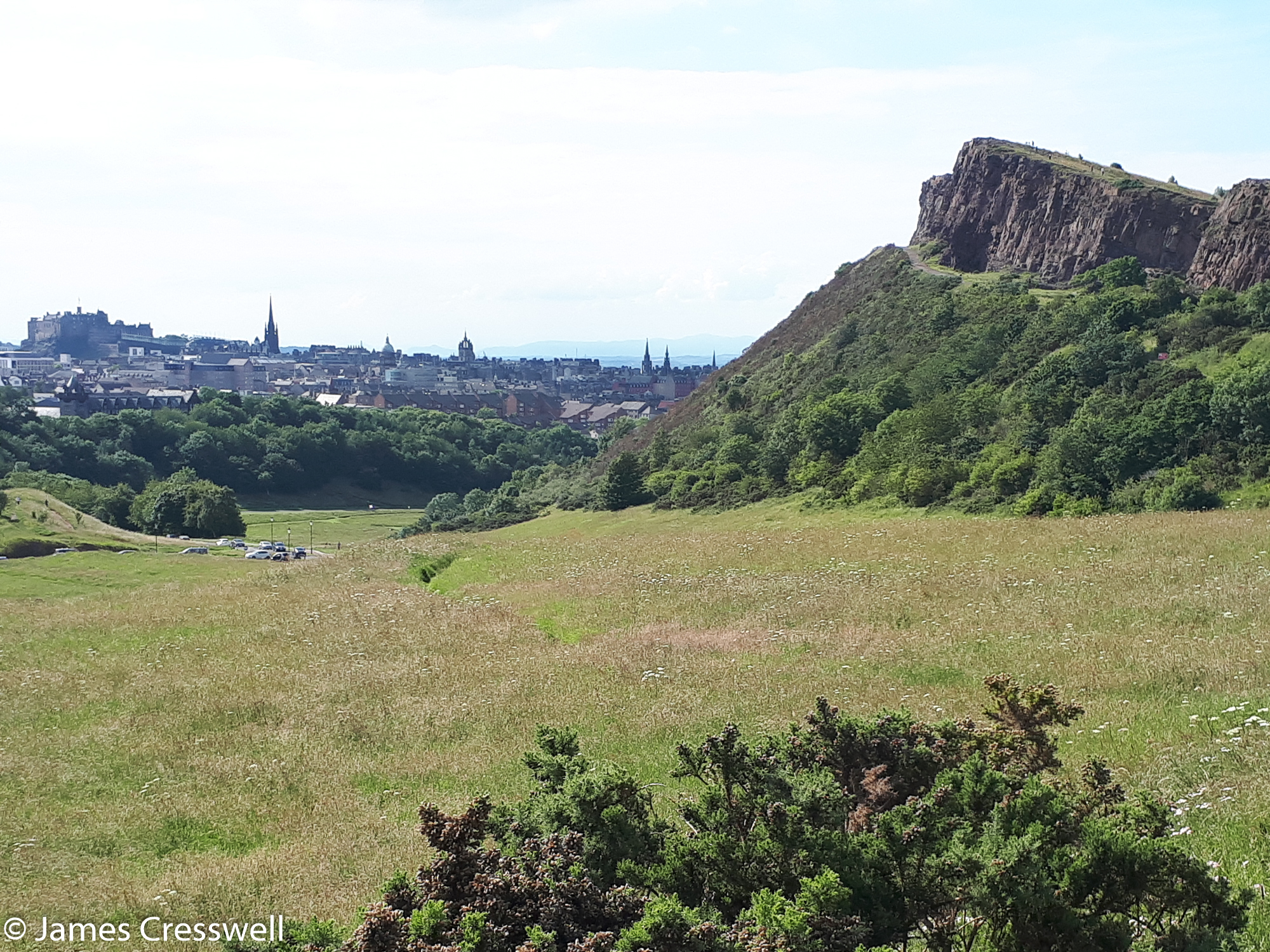
Salisbury Crags in Holyrood Park, Edinburgh. Hutton's Section is located at the base of the crags (Day 8)
Itinerary
Day 1: Arrive in Edinburgh, Capital of Scotland. Our hotel is on the tram line 15 minutes from the international airport and 15 minutes from the city centre. It is also 200m from a train station.
Day 2: Siccar Point, Forth Bridge World Heritage Site and Cairngorms National Park. Our tour starts with a bang, visiting what has been described as the World's most important geosite: Siccar Point. Siccar Point is an unconformity with Devonian sediments lying on Silurian sediments. It is at this location in 1788 that Father of Geology, James Hutton first realised the enormity of geological time. Siccar Point is 1 hour drive east of Edinburgh. After visiting Siccar Point we double back to the Edinburgh area having lunch at the Forth Bridge World Heritage Site. We then head north towards the Highlands, where all the other geosites of the tour are located. Our first stop on our way north is the village of Birnam which is situated on the Highland Boundary Fault, an important geological fault which marks the entry to the Highlands. In Birnam we see the famous Birnam Oak which is mentioned in William Shakespeare's play: Macbeth. We then continue on to the Queens View where we can view Schiehallion Mountain. The mountain is an important geosite because in 1776 it was used in an experiment to estimate the mass of the earth. We then enter the Cairngorms National Park and spend the night at Aviemore.
Day 3: Cairngorms National Park, Loch Ness and the North West Highlands Geopark. Our first stop of the day is the shore of Loch Ness. The loch lies on the Great Glen Fault which separates the Grampian Highlands from the North West Highlands. This strike-slip fault is about 300 miles long and it has a complex movement history; comparatively recent Ice Age glacial erosion along the fault has formed the loch. The loch is by volume the largest freshwater body in the British Isles, containing more water than all the lakes of England and Wales combined! The loch is best known for the alleged sightings of the cryptozoological monster, Nessie, which we will also try to spot! From Loch Ness we pass through Inverness, the capital of the Highlands, to reach Cromarty on the Black Isle, which is actually a peninsula rather than an island. Our reason for visiting Cromarty is the story of Hugh Miller who was Scotland's leading Victorian palaeontologist. He discovered many Devonian fossil fish, several Silurian sea scorpions and has a North Sea oilfield named after him. In Cromarty we will visit an outcrop of Devonian limestone from which Miller once collected fossil fish and we will visit his former home which is now a museum containing some of his fossils. After lunch in Cromarty we travel on to Lairg to visit the Ferrycroft Visitor Centre where we learn all about a huge meteorite crater that has recently been found to be lying underneath the town. We then continue to the North West Highlands Geopark, and visit the famous Knockan Crag. Here we learn about the Highland Controversy and it was resolved by discovering the world's first identified thrust fault: The Moine Thrust. After spending an hour and a half here, which includes looking at information boards, a geological walk and being able to put our hands on the actual thrust plane, we continue to the fishing village of Ullapool, which despite its small size is the largest settlement for many miles around. We will be spending the next two nights in Ullapool and arrive early enough for you to explore the area.
Day 4: The North West Highlands Geopark. Our first stop of the day is at Stronechrubie Cliffs where we see imbricated thrust slices in Cambrian dolostone and a dyke. This is followed by the classic sequence of Cambrian rocks along the Loch Assynt shoreline, which we were introduced to at the Knockan Crag visitor centre. We then stop at a site to view a 'double unconformity' where Cambrian rock unconformably lies on one billion year old Torridonian sandstone which itself unconformably lies on three billion year old Lewisian gneiss. Following this we reach Glencoul and one of the most gazed-upon views in Scottish geology; here the Ben More Thrust, forces 3 billion year old Lewisian gneiss over Cambrian sedimentary rocks. Next we visit Scourie to see the oldest rocks in the British Isles: the Scourie Gneiss (part of the Lewisian gneisses) which are 3 billion years old and are cut by the remarkable Scourie Dykes that are 2 billion years old. This is followed by the 'Multi-coloured Rock Stop' which is Laxfordian gneiss (also part of the Lewisian) and cut by Scourie dykes and granite dykes. This stop is also the most northern point of the tour and from here we head south, stopping for lunch at the Rock Stop Cafe in the Northwest Highlands Geopark Visitor Centre. From here we return to Loch Assynt and head west along the loch stopping at an unconformity between Torridonian sandstone and the much older Lewisian gneiss before reaching a viewpoint of the Assynt Foreland Mountains which have been voted by the British Geological Survey to be the UK and Ireland's number one Geosite. From here we continue to the villages of Stoer and Clachtoll. Here we again see Torridonian sediments lying unconformably on a surface of Lewisian gneiss that has extreme topography, with deep canyons. We also take a 30 minute walk (each way) to see the ejecta deposits of the Lairg meteorite. We then return to Ullapool for a second night, optionally stopping at Ardvreck castle on the shores of Loch Assynt enroute.
Day 5: The road to the Isle of Skye, and a boat trip to Loch Coruisk in the heart of Skye's Black Cuillin. Today we head south towards the Isle of Skye. En-route we stop at the magnificent Corrieshalloch Gorge, where melt water at the end of the Ice Age carved a deep gorge as the surrounding land was rising upwards due to isostatic rebound. Our next stop is for a photo of Eilean Donan Castle, before we cross the road bridge to the Isle of Skye, where we stop for a picnic lunch. We then continue to the pretty fishing village of Elgol, where we take a boat trip with Misty Isles to Loch Coruisk in the heart of the Black Cuillin Mountains. These mountains are perhaps the most spectacular in Britain and are made up of the eroded magma chamber from a volcano that was active during the splitting of the Atlantic 55 million years ago. We have 1.5 hours ashore to examine the layered gabbros, see many glacial erratics and admire the glaciated scenery. There is also the opportunity to see many seals. On our return to Elgol, we stop to see honeycomb weathering in the Jurassic sandstones. We then spend the night in Skye's main town Portree.
Day 6: The Isle Of Skye's Dinosaurs. The morning is spent on the Trotternish Peninsula in the north of the Isle of Skye. Our first stop is the Quirang where we see the largest mass movement landslide in Britain. Here a 2km long, 300m thick slab of Paleogene lavas slipped over weaker Jurassic sediments at the end of the last Ice Age. We then visit the Dinosaur Museum at Staffin, where we will meet Dugie Ross, the discoverer of many of the Skye dinosaur bones and trackways. The Isle of Skye has five different dinosaur trackway sites and is the best place in the world to find mid-Jurassic dinosaurs. Three of these sites occur at Brothers' Point (Rubha nam Brathairean) which is our next stop. Site one has 35 tracks in three different trackways, site two has 49 tracks in two different trackways and site three has 18 tracks in two different trackways. After a brief stop at Kilt Rock, where we can see a Paleogene sill intruded between Jurassic sediments, we head south, passing the Old Man of Storr and, later, the Red Cuillin Mountains before reaching Armadale. Here we take the ferry back to the mainland of Scotland and drive on to Acharacle in the Lochaber Geopark, where we spend the next two nights.
**Stops on days 5 & 6: the dinosaur tracks can only be seen on a low tide, if the tide is unfavourable on day 6 we will visit them on day 5 instead switching the other stops around accordingly**
Day 7: Fingal's Cave - Staffa, puffins and Ardnamurchan volcano. We start the day driving through the Lochaber Geopark to reach Kilchoan on the edge of the Ardnamurchan volcano. Here we board a boat and take a tour to the legendary Fingal's Cave on the island of Staffa. Here we see the incredible columnar basalt. On the tour we also stop at the island of Lunga in the Treshnish Isles to see puffins and thousands of breeding guillemots (please see the wildlife photo gallery below). On our return to Kilchoan we examine the Ardnamurchan volcano which like the Black Cuillin is the eroded magma chamber of a Tertiary volcano. We then return to Acharacle for a second night.
Day 8: The Lochaber Geopark, Loch Lomond and Trossachs National Park and Edinburgh. First thing in the morning we pass through the village of Strontian after which the element Strontium is named, and then we then reach the Corran ferry, which takes us and our vehicle across Loch Linnhe and the Great Glen Fault. We then stop at Ballachulish where we visit a slate quarry. After the quarry we head into the dramatic Glencoe. This spectacular glaciated valley is cut into the remains of an explosive Devonian volcano that once had an enormous eruption. In Glencoe we stop at several sites, seeing rhyolite, waterfalls and the amazing views. We also learn about the violent history and the Massacre of Glencoe. We then leave the Lochaber Geopark and travel on through the Loch Lomond and Trossachs National Park making a short comfort stop, before stopping for lunch at the Falkirk Wheel. This is an ingenious lift that raises boats from one canal level up to another. From here we continue to the city of Edinburgh where we have one final stop: Hutton's Section on Salisbury Crags. Salisbury Crags and Arthur's Seat are the remains of a Carboniferous volcano and are right in the heart of Edinburgh. At Hutton's Section we see how dolerite forced its way into the surrounding sedimentary rocks as a sill. James Hutton was the first to describe this process. We then end our tour at a nearby hotel where we spend the night.
Day 9: Edinburgh and Departure. The tour officially ends after breakfast and you are free to depart, perhaps by taking a taxi to Waverley station for train connections to the rest of the UK and tram connections to the airport. However it is highly recommended that you stay one or two extra days in Edinburgh to explore on your own. The city centre is a World Heritage Site and is built on two Carboniferous volcanoes sculpted by glacial ice. Edinburgh Castle is built on top of one of the volcanic vents and Arthur's Seat is the other volcano. The National Museum has an excellent geological exhibition as does the Dynamic Earth Museum. For fit people, climbing Arthur's Seat is a fantastic thing to do. Additionally the National Mining Museum of Scotland is 10 miles from the city and can be reached by bus, train or taxi.
INCLUDED
Geological guiding from James Cresswell
Historical and archaeological guiding from Abby Cresswell
Transportation from destination to destination
Hotel accommodation, normally 3 Star with en-suite bathrooms
Breakfast in the hotels
Boat to Loch Coruisk, Isle of Skye
Boat tour to Fingal's Cave, Staffa
NOT INCLUDED
Flights
Lunch and dinner
Transportation by tram to and from airport
Video clip from boat trip to Fingal's Cave
CARBON GENERATED BY THIS TOUR
We purchase carbon offsets through Carbon Footprint.
= 0.65 TONNES OF CO2
(calculated at https://www.carbonfootprint.com/calculator.aspx and using a rate of 0.12 kg/km for ferry/boat travel)
At no additional cost to you, GeoWorld Travel will offset the Carbon created by this tour using carbon offsetting company Carbon Footprint. A certificate for this offset will be supplied to you after the tour is completed.
It is your responsibility to book your travel to and from the start and finish of the tour, so if you would like to also carbon offset this cost please use our carbon offset calculator here.
Trip diaries, photo galleries and reviews of previous trips
TRIP DIARY 2024
A summary of the trip with captioned photos
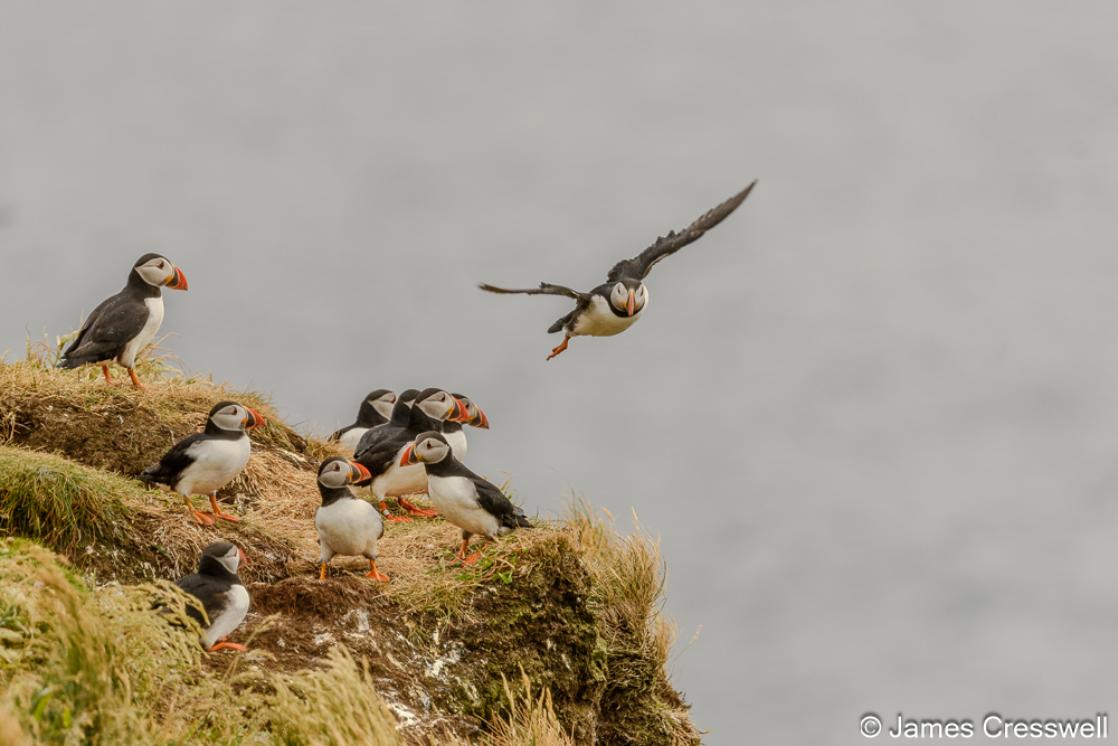
TRIP DIARY 2023
A summary of the trip with captioned photos
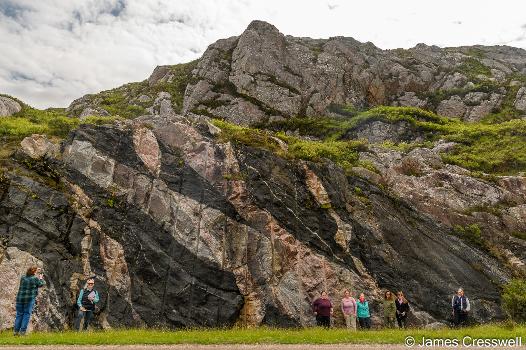
TRIP DIARY 2022
A summary of the trip with captioned photos
TRIP DIARY 2021
A day by day account of the trip with captioned photos
TRIP DIARY 2019
A day by day account of the trip with captioned photos
SCOTLAND - THE BIRTH OF GEOLOGY (2023)
"I have traveled with Geoworld Travel twice now, to Scotland and to Morocco, and both times Geoworld Travel has come through spectacularly. You just cannot beat the breadth of sites visited in the time given - you see so much, places way off the beaten path that are stunning to boot. Everything is well planned, and the pace of the journey is still good even with everything packed in. Accommodations and food are well done too."
Caitlin D., Virginia, USA
Review was posted to Tripadvisor, August 2022
SCOTLAND - THE BIRTH OF GEOLOGY (2023)
"We just completed an exciting and well planned trip to Scotland with James and Abbey hosting. James is a talented geologist and photographer. Abbey has an archeology background and was able to fill us in on archeological sites we encountered. We traveled to many significant and world famous sites related to Scotland's extensive geological history; At each site James explained the geological significance of each site. These included the famous Siccar's Point, the Moine Thrust, Glencoe Thrust, Fingal's cave, the Scourie Dykes, the Quirang, just to name a few. Along the way we visited several museums, and were exposed to the culture, history and natural life of Scotland. Both James and Abbey did their very best to make sure we saw all the sites. If you have an interest in geology and the natural world or just love Scotland, you will enjoy this trip. Highly recommend this trip!"
Deborah L., Tennessee, USA
Review sent to us by email, June 2023
SCOTLAND - THE BIRTH OF GEOLOGY (2023)
"WOW. Wow, wow, wow, wow. It was all So, so wonderful, from start to finish. I don’t even know where to begin to thank you for all your meticulous planning of every day and every detail and every drop of knowledge so generously shared, and all your kindness and all your patience and your lovely personalities and your senses of humor and on and on and on and on…. It was just The Most Fabulous Trip and I can’t thank you enough!!!!"
Barbara F., Maryland, USA
Review sent to us by email, June 2023
SCOTLAND - THE BIRTH OF GEOLOGY (2023)
"On a tour of Scotland, our small group was treated to the various geologic wonders it holds. Led by James, a knowledgeable and prepared guide, we saw as much as one can in eight days. The locations are selected with thought and intention to tell a full story. We were driven to remote locations with skill and comfort. The accommodations were so comfortable that I plan to write excellent reviews for each one. I highly recommend this company and plan to travel with them again."
Anna K., Minnesota, USA
Review was posted to Tripadvisor, June 2023
SCOTLAND - THE BIRTH OF GEOLOGY (2022)
"Comprehensive tour of the geology of Scotland, with multiple geosites each day. Started at Siccar Point, and ended with Hutton's Section, illustrating not only the fascinating geology, but also the development of geology as a science. Traversed the progression of geologic terrains as we headed out from Edinburgh, and upon our return. This trip is suitable for all levels of interest in geology, from practicing professionals to people who want to explore the natural world. This trip ranks high in the beauty of the countryside itself, in addition to the knowledge acquired and the opportunity to discuss what we were looking at with experienced geologists."
Linda B., Arizona, USA
Review was posted to Tripadvisor, August 2022
SCOTLAND - THE BIRTH OF GEOLOGY (2021)
"I went to the Scotland trip a few weeks ago. It was really fabulous. It was like traveling back in time 3 billion years ago until now. James guided us through so many landscapes and places. I've learned so much. It was my first trip with GeoWorld Travel, and certainly will not be my last :-)"
Sophie G., Oxfordshire, UK
Review was posted to Google, October 2021
Scotland - The Birth of Geology (2019)
"Following my participation on the 2019 Scottish Birth of Geology tour, I am now reading geological books and poring over geological maps. This nine day tour of Scotland left me intrigued to learn more. I am a working geologist in the US, and this GeoWorld tour rekindled my fascination with my field. I am a student once again. James and Abbey organized and ran a marvelous trip for the 10 of us. James is a remarkably well rounded geologist. He is able to focus our view of the landscape and convey the scientific significance of our observations.
I cannot get the vision of dramatic Suilven out of my head. This Precambrian sandstone monolith rests uncomformably atop 3 billion year old Lewisian Gneiss and marks the edge of the thrust belt marking crustal collisions. Thank you for bringing us to so many marvelous places and for firing up my fascination with our earth!"
Kenneth T., Oregon, USA
Review was posted to Facebook, August 2019
Scotland - The Birth of Geology (2019)
"James and Abby were a delight to spend a week with; they even made the rainy Scottish weather enjoyable. As ateacher of high school geology I know just enough to realize that learning the story of this incredibly complex land is a daunting task in a week, but James accomplished this by always making sure we had the "big picture" firmly in place before we delved into details. He can reach across the breadth of the spectrum to make sure everyone in the group is learning things that are accessible to them. We were also incredibly lucky to have Abby (she and James are married) along on our tour and her command of Scotland's history only added to my appreciation for the places that we visited; she added depth and a historical context to where we were that I found exceptionally helpful. This trip was just the right length of time and I received an exceptional value returned in knowledge for what I invested in the trip; I hope to join James again on a future trip!!"
Rob G., Colarado, USA
Review was posted to TripAdvisor, July 2019
SCOTLAND - THE BIRTH OF GEOLOGY (June 2018)
"We highly recommend Geoworld Travel. Scotland geology tour was outstanding with just the right number of stops and side trips featured every day. Upbeat, enthusiastic and knowledgeable, James was the perfect guide, happy to talk geology, history, everything really. Lodging arrangements were flawless."
James C., Oregon, USA
Review was posted to Google, December 2018
SCOTLAND - THE BIRTH OF GEOLOGY (June 2018)
"We had an absolutely wonderful time on 'The birth of Geology tour' of Scotland. The trip exceeded our expectations. When we returned home, I found myself telling friends how around every bend in the road we were greeted by a 'million dollar view'. The striking combination of white sand beaches and steep cliffs at Clactoll and Sango Bay, the desolate and beautiful Rhiconich, sparkling waters surrounding the towering Red and Black Cuillins, I could go on and on. Our trip was enjoyable due, in no small part, to the small number of people (6) in the group. We all got along and had many great discussions. It was a personal and authentic experience that did not feel rushed. Our tour guide James was easygoing and flexible often letting us vote on what we would like to do (supper, length of time at a stop).
The tour is best summed up by the bittersweet feelings I had on the last day - I found myself feeling so sad this tour was ending but I couldn't stop smiling thinking of all the great memories made. We owe a very big thank you to James - our charismatic and knowledgeable tour guide. Best of luck in the future growing your business!"
Patrick M., Labrador, Canada
Review was posted to TripAdvisor, June 2018
Scotland - The Birth of Geology (May 2018)
"We went on Scotland Geo trip, and James took us around Scotland's most significant Geo sites. Tour was great. James took care of little details and engaged our entire group in Geology, and casual conversations, throughout the trip. I admire his stamina! He also brought along reference materials for us to read up should we like to learn more. Excellent tour!"

